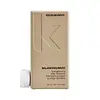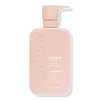What's inside
What's inside
 Key Ingredients
Key Ingredients

 Benefits
Benefits

 Concerns
Concerns

 Ingredients Side-by-side
Ingredients Side-by-side

Water
Skin ConditioningSodium Cocoyl Isethionate
CleansingCocamidopropylamine Oxide
CleansingCocamidopropyl Hydroxysultaine
CleansingGlycol Distearate
EmollientHydrolyzed Wheat Protein
Skin ConditioningPanthenol
Skin ConditioningHydrolyzed Soy Protein
HumectantHydrolyzed Vegetable Protein
Skin ConditioningWheat Amino Acids
Skin ConditioningTocopheryl Acetate
AntioxidantGuar Hydroxypropyltrimonium Chloride
Skin ConditioningPEG-150 Distearate
EmulsifyingPolyquaternium-7
Polyquaternium-11
Polyamide-2
PEG-4 Rapeseedamide
Sodium Lauroyl Sarcosinate
CleansingDecyl Glucoside
CleansingMethyl Gluceth-20
HumectantGlycereth-26
HumectantCamellia Sinensis Leaf Extract
AntimicrobialHydrolyzed Grape Fruit Extract
HumectantUrtica Dioica Extract
AstringentSalvia Officinalis Extract
AntimicrobialCinnamidopropyltrimonium Chloride
Butylene Glycol
HumectantHelianthus Annuus Seed Extract
Skin ConditioningSuperoxide Dismutase
AntioxidantMelanin
Skin ProtectingAscorbic Acid
AntioxidantLactic Acid
BufferingMalic Acid
BufferingPhenoxyethanol
PreservativeEthylhexylglycerin
Skin ConditioningParfum
MaskingBenzyl Benzoate
AntimicrobialBenzyl Salicylate
PerfumingCitronellol
PerfumingLinalool
PerfumingWater, Sodium Cocoyl Isethionate, Cocamidopropylamine Oxide, Cocamidopropyl Hydroxysultaine, Glycol Distearate, Hydrolyzed Wheat Protein, Panthenol, Hydrolyzed Soy Protein, Hydrolyzed Vegetable Protein, Wheat Amino Acids, Tocopheryl Acetate, Guar Hydroxypropyltrimonium Chloride, PEG-150 Distearate, Polyquaternium-7, Polyquaternium-11, Polyamide-2, PEG-4 Rapeseedamide, Sodium Lauroyl Sarcosinate, Decyl Glucoside, Methyl Gluceth-20, Glycereth-26, Camellia Sinensis Leaf Extract, Hydrolyzed Grape Fruit Extract, Urtica Dioica Extract, Salvia Officinalis Extract, Cinnamidopropyltrimonium Chloride, Butylene Glycol, Helianthus Annuus Seed Extract, Superoxide Dismutase, Melanin, Ascorbic Acid, Lactic Acid, Malic Acid, Phenoxyethanol, Ethylhexylglycerin, Parfum, Benzyl Benzoate, Benzyl Salicylate, Citronellol, Linalool
Water
Skin ConditioningCocamidopropyl Betaine
CleansingDisodium Laureth Sulfosuccinate
CleansingSodium Cocoyl Isethionate
CleansingGlycerin
HumectantSodium Chloride
MaskingAcrylates Copolymer
Phenoxyethanol
PreservativeCocamide Mipa
EmulsifyingSodium Lauroyl Sarcosinate
CleansingSodium Benzoate
MaskingGlycol Distearate
EmollientParfum
MaskingPolyquaternium-10
Hydroxypropyl Guar Hydroxypropyltrimonium Chloride
Cocos Nucifera Oil
MaskingGlyceryl Oleate
EmollientCoco-Glucoside
CleansingPolyquaternium-7
Polyquaternium-11
Benzyl Alcohol
PerfumingButyrospermum Parkii Butter
Skin ConditioningEthylhexylglycerin
Skin ConditioningCitric Acid
BufferingHexyl Cinnamal
PerfumingGlycol Stearate
EmollientLinalool
PerfumingSodium Sulfite
PreservativeTocopheryl Acetate
AntioxidantCoconut Acid
CleansingIsopropanolamine
BufferingTocopherol
AntioxidantHydrolyzed Keratin
HumectantButylene Glycol
HumectantWater, Cocamidopropyl Betaine, Disodium Laureth Sulfosuccinate, Sodium Cocoyl Isethionate, Glycerin, Sodium Chloride, Acrylates Copolymer, Phenoxyethanol, Cocamide Mipa, Sodium Lauroyl Sarcosinate, Sodium Benzoate, Glycol Distearate, Parfum, Polyquaternium-10, Hydroxypropyl Guar Hydroxypropyltrimonium Chloride, Cocos Nucifera Oil, Glyceryl Oleate, Coco-Glucoside, Polyquaternium-7, Polyquaternium-11, Benzyl Alcohol, Butyrospermum Parkii Butter, Ethylhexylglycerin, Citric Acid, Hexyl Cinnamal, Glycol Stearate, Linalool, Sodium Sulfite, Tocopheryl Acetate, Coconut Acid, Isopropanolamine, Tocopherol, Hydrolyzed Keratin, Butylene Glycol
 Reviews
Reviews

Ingredients Explained
These ingredients are found in both products.
Ingredients higher up in an ingredient list are typically present in a larger amount.
Butylene Glycol (or BG) is used within cosmetic products for a few different reasons:
Overall, Butylene Glycol is a safe and well-rounded ingredient that works well with other ingredients.
Though this ingredient works well with most skin types, some people with sensitive skin may experience a reaction such as allergic rashes, closed comedones, or itchiness.
Learn more about Butylene GlycolEthylhexylglycerin (we can't pronounce this either) is commonly used as a preservative and skin softener. It is derived from glyceryl.
You might see Ethylhexylglycerin often paired with other preservatives such as phenoxyethanol. Ethylhexylglycerin has been found to increase the effectiveness of these other preservatives.
Glycol Distearate serves as a pearlizing or opacifying agent in cosmetic products.
It's often included in cleansers and haircare products to give them a lustrous or shimmering appearance.
It is derived from stearic acid, a natural fatty acid commonly found in vegetable oils and animal fats.
Glycol Distearate isn't fungal acne safe.
Learn more about Glycol DistearateLinalool is a fragrance and helps add scent to products. It's derived from common plants such as cinnamon, mint, citrus, and lavender.
Like Limonene, this ingredient oxidizes when exposed to air. Oxidized linalool can cause allergies and skin sensitivity.
This ingredient has a scent that is floral, spicy tropical, and citrus-like.
Learn more about LinaloolParfum is a catch-all term for an ingredient or more that is used to give a scent to products.
Also called "fragrance", this ingredient can be a blend of hundreds of chemicals or plant oils. This means every product with "fragrance" or "parfum" in the ingredients list is a different mixture.
For instance, Habanolide is a proprietary trade name for a specific aroma chemical. When used as a fragrance ingredient in cosmetics, most aroma chemicals fall under the broad labeling category of “FRAGRANCE” or “PARFUM” according to EU and US regulations.
The term 'parfum' or 'fragrance' is not regulated in many countries. In many cases, it is up to the brand to define this term.
For instance, many brands choose to label themselves as "fragrance-free" because they are not using synthetic fragrances. However, their products may still contain ingredients such as essential oils that are considered a fragrance by INCI standards.
One example is Calendula flower extract. Calendula is an essential oil that still imparts a scent or 'fragrance'.
Depending on the blend, the ingredients in the mixture can cause allergies and sensitivities on the skin. Some ingredients that are known EU allergens include linalool and citronellol.
Parfum can also be used to mask or cover an unpleasant scent.
The bottom line is: not all fragrances/parfum/ingredients are created equally. If you are worried about fragrances, we recommend taking a closer look at an ingredient. And of course, we always recommend speaking with a professional.
Learn more about ParfumPhenoxyethanol is a preservative that has germicide, antimicrobial, and aromatic properties. Studies show that phenoxyethanol can prevent microbial growth. By itself, it has a scent that is similar to that of a rose.
It's often used in formulations along with Caprylyl Glycol to preserve the shelf life of products.
We don't have a description for Polyquaternium-11 yet.
Polyquaternium-7 is a light to clear colored liquid. It is commonly found in haircare products for its film-forming and anti-static properties.
According to a manufacturer, it is a non-paraben and specially developed for negatively charged surfactant systems. This makes it a great hairstyle holder and helps to improve wet hair detangling without adding buildup.
Sodium cocoyl isethionate is a natural ingredient from coconut oil. It is an ultra gentle cleanser that gives a nice foam without drying the skin or impacting the skin barrier.
The amount of foam created depends on the amount of sodium cocoyl isethionate used in the product.
This ingredient also helps improve the spreadability of a product.
Learn more about Sodium Cocoyl IsethionateSodium Lauroyl Sarcosinate is a cleansing agent and emulsifier. It is a surfactant derived from sarcosine, and a common source is coconut oil.
As a surfactant, Sodium Lauroyl Sarcosinate helps lift dirts, oil, and other molecules to be washed away. In leave-on products, this ingredient is used as an emulsifier. Emulsifier help prevent ingredients such as oils and waters from separating.
Sodium Lauroyl Sarcosinate is also commonly found as a foaming agent in shampoo, toothpaste, and shaving foam. It is amphiphilic, meaning it loves both water and fats.
Tocopheryl Acetate is AKA Vitamin E. It is an antioxidant and protects your skin from free radicals. Free radicals damage the skin by breaking down collagen.
One study found using Tocopheryl Acetate with Vitamin C decreased the number of sunburned cells.
Tocopheryl Acetate is commonly found in both skincare and dietary supplements.
Learn more about Tocopheryl AcetateWater. It's the most common cosmetic ingredient of all. You'll usually see it at the top of ingredient lists, meaning that it makes up the largest part of the product.
So why is it so popular? Water most often acts as a solvent - this means that it helps dissolve other ingredients into the formulation.
You'll also recognize water as that liquid we all need to stay alive. If you see this, drink a glass of water. Stay hydrated!
Learn more about Water